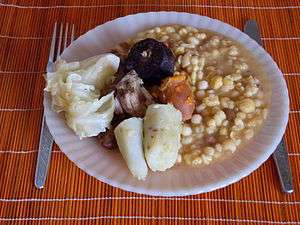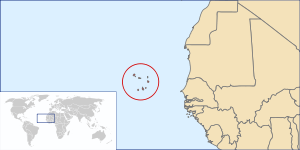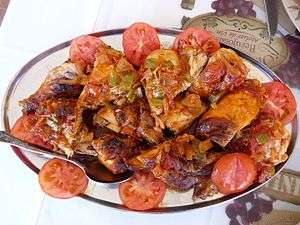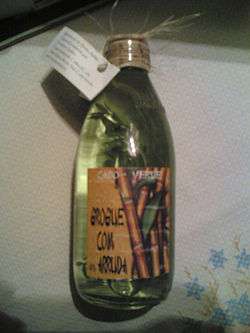Cape Verdean cuisine





The cuisine of Cape Verde is a West African cuisine largely influenced by Portuguese, Southern and Western European and West African cuisine. Cape Verde was a colony of Portugal from its colonization until 1975.[1]
Because the archipelago is inside the Atlantic Ocean, fish is very important in Cape Verdean cooking.
Overview
One of the most important aspects of Cape Verdean culture is the beverage grogue, a strong rum made from distilled sugar cane on the islands of Santo Antao and Santiago. The beverage is made in towns such as Paul on Santo Antao and Cidade Velha on Santiago using a trapiche. A variation of the drink is ponche (punch) which is sweetened with condensed milk or sugarcane molasses. Due to the intoxication on consuming grogue, it is consumed by many Cape Verdean musicians seeking inspiration.[2]
Corn and beans are staples of Cape Verdean cuisine.[3] Also popular are rice, fried potatoes, cassava and vegetables such as carrots, kale, squash, fish and meat such as tuna, sawfish, lobster, chicken, grilled pork and eggs. One legacy of the Portuguese on the islands is olives and Alentejo wines which are still imported.[4] Some tourists also east Capeverdean dishes in restaurants especially in hotels and resorts.
Cachupa, a stew is considered the national dish of Cape Verde which includes mashed maize, onions, green bananas, manioc, sweet potatoes, squash and yams . Manioc balls are one of the most common in Cape Verde.[5]
Seafood dishes include baga and búzio cabra, made out of the bubonian conch (Persististrombus latus).
In December 2002, the Cape Verdean government prohibited the killing of turtles by law, per their participation in the Convention on Biological Diversity in 1995 e a Convenção sobre Comercio Internacional de Espécies de Fauna e Flora Selvagem Ameaçadas de Extinção (CITES).[6] The dish once popular on Santiago Island named turtle steak slowly no longer consumed.
Strela is Cape Verde's most popular beer who started production in 2006, it superseded Portuguese beers including Super Bock and Sagres (in 2009).[7]
Meals
- Manel Antone stew - beef stew
- Antonense shrimp stew (conserva de camarãо) - found in Santo Antão
- Antonense pork stew (conserva de carne de porco) - found in Santo Antão
- Arroz de cabidela de marisco а dadal - the rice seafood dish of the island of São Vicente
- Bafa - a dish with squid, fries and rice
- Bibi-style shrimp dish (Caldo de camarãо а moda da mama Bibi - seafood dish mainly originated in Chã das Pedras southwest of Ribeira Grande on the island of Santo Antão
- Búzio cabra - seafood made out of the Bubonian Conch (Persististrombus latus), a sea snail
- Cachupa - corn/maize dish, the national dish of Cape Verde, varieties include cachupa frita, cachupa guisada or cachupa refogada, meaning "fried cachupa" and two styles, cachupa rica tends to have more ingredients than the simpler, cachupa pobre.[3]
- Chamuças, Capeverdean samosas dish, a dish originated from the Indian subcontinent
- Couscous - one of the most popular in Cape Verde, the Capeverdean style featured molasses and horse cheese
- Fried moray - common on the island of São Vicente
- Goat cheese with papaya jam
- Grilled chicken with tomatoes - a dish popular on the island of Fogo
- Grilled peas - a dish popular on the island of Fogo
- Grogue or Capeverdean grog - alcoholic (nowadays also non-alcoholic) beverage, popular on the islands of Santo Antão and Santiago[8]
- Guisado de percebes (barnacle stew) - dish of the island of São Vicente
- Lobster stew
- Shrimp in garlic wine (camarãо em vinha de alhos) - shrimp dish
- Turtle steak (bife de tartaruga) - no longer used today, then popular on the island of Santiago
- Xerém - a soup dish, the name etymology is of Arab origin (probably harem) and possibly of Yóruba origin (sheren)
Beverages
- Strela - beer
- Several variety of wines from Chã das Caldeiras including Santa Luzia and Brava
Desserts
- Bolinhos de mandioca com mel or Litte manioc balls with honey, also known as Honey manioc balls
See also
References
- ↑ King, Russell (2001). The Mediterranean Passage: Migration and New Cultural Encounters in Southern Europe. Liverpool University Press. p. 104. ISBN 0-85323-646-1.
- ↑ Flood, Callie (July 2010). Cape Verde (Other Places Travel Guide). Other Places Publishing. p. 35. ISBN 978-0-9822619-2-7.
- 1 2 Raymond Almeida. "Cachupa di Cabo Verde". UMassD.
- ↑ Ham, Anthony (2009). West Africa. Lonely Planet. p. 233. ISBN 978-1-74104-821-6.
- ↑ Maria Augusta Carvalho (2013). Comeres de África Falados em Português. Casa das Letras. p. 129. ISBN 978-972-46-2188-3
- ↑ "Cabo Verde: Tartarugas marinhas ameaçadas de extinção em menos de dez anos - RTP Notícias". ww1.rtp.pt. Archived from the original on 2012-02-29. Retrieved 2008-07-07.
- ↑ "Cabo Verde: Cerveja Strela ultrapassou Sagres e quer passar Superbock" [Strela drink Surpassed Sagres and to Surpass Superbock]. SAPO CV (in Portuguese). 27 November 2009. Retrieved 10 November 2016.
- ↑ "Grogue Official". Grogue Official. Retrieved 13 October 2016.
Further reading
- Virginia Vieira Silva, Cuisine des îles du Cap-Vert (Cuisine of the Cape Verde Islands), Paris: L'Harmattan, 1989, 222 p. ISBN 9782296158283 (in French)
External links
- Cape Verde Gastronomy Capeverde.com